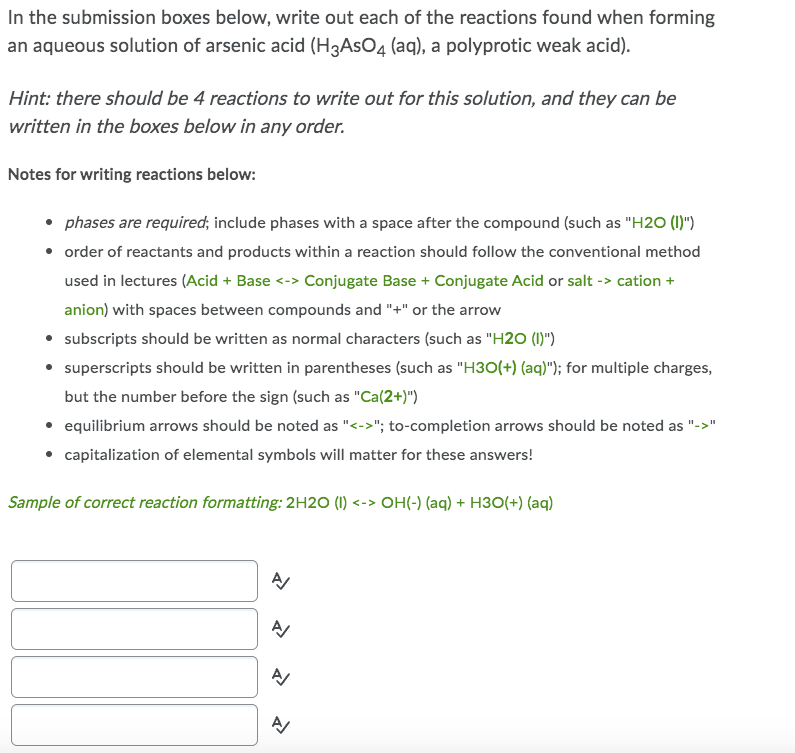the submission boxes below, write out each of the reactions found when forming aqueous solution of arsenic acid (H3AsO4 (aq), a polyprotic weak acid). int: there should be 4 reactions to write out for this solution, and they can be itten in the boxes below in any order. tes for writing reactions below: phases are required, include phases with a space after the compound (such as "H20 (1)") • order of reactants and products within a reaction should follow the conventional method used in lectures (Acid + Base <-> Conjugate Base + Conjugate Acid or salt -> cation + anion) with spaces between compounds and "+" or the arrow • subscripts should be written as normal characters (such as "H20 (1)") • superscripts should be written in parentheses (such as "H3O(+) (aq)"); for multiple charges, but the number before the sign (such as "Ca(2+)") equilibrium arrows should be noted as "<->"; to-completion arrows should be noted as • capitalization of elemental symbols will matter for these answers! mple of correct reaction formatting: 2H2O (1) <-> OH(-) (aq) + H3O(+) (aq) A/ A A
the submission boxes below, write out each of the reactions found when forming aqueous solution of arsenic acid (H3AsO4 (aq), a polyprotic weak acid). int: there should be 4 reactions to write out for this solution, and they can be itten in the boxes below in any order. tes for writing reactions below: phases are required, include phases with a space after the compound (such as "H20 (1)") • order of reactants and products within a reaction should follow the conventional method used in lectures (Acid + Base <-> Conjugate Base + Conjugate Acid or salt -> cation + anion) with spaces between compounds and "+" or the arrow • subscripts should be written as normal characters (such as "H20 (1)") • superscripts should be written in parentheses (such as "H3O(+) (aq)"); for multiple charges, but the number before the sign (such as "Ca(2+)") equilibrium arrows should be noted as "<->"; to-completion arrows should be noted as • capitalization of elemental symbols will matter for these answers! mple of correct reaction formatting: 2H2O (1) <-> OH(-) (aq) + H3O(+) (aq) A/ A A
Chapter3: Mechanisms
Section: Chapter Questions
Problem 31EQ: The reaction just described is reversible. Deprotonation of the conjugate acid of an organic base by...
Related questions
Question

Transcribed Image Text:In the submission boxes below, write out each of the reactions found when forming
an aqueous solution of arsenic acid (H3AsO4 (aq), a polyprotic weak acid).
Hint: there should be 4 reactions to write out for this solution, and they can be
written in the boxes below in any order.
Notes for writing reactions below:
• phases are required; include phases with a space after the compound (such as "H20 (1)")
• order of reactants and products within a reaction should follow the conventional method
used in lectures (Acid + Base <-> Conjugate Base + Conjugate Acid or salt -> cation +
anion) with spaces between compounds and "+" or the arrow
• subscripts should be written as normal characters (such as "H20 (1)")
• superscripts should be written in parentheses (such as "H3O(+) (aq)"); for multiple charges,
but the number before the sign (such as "Ca(2+)")
• equilibrium arrows should be noted as "<->"; to-completion arrows should be noted as "->"
• capitalization of elemental symbols will matter for these answers!
Sample of correct reaction formatting: 2H2O (1) <-> OH(-) (aq) + H3O(+) (aq)
1
A
Expert Solution
This question has been solved!
Explore an expertly crafted, step-by-step solution for a thorough understanding of key concepts.
Step by step
Solved in 2 steps with 2 images

Knowledge Booster
Learn more about
Need a deep-dive on the concept behind this application? Look no further. Learn more about this topic, chemistry and related others by exploring similar questions and additional content below.Recommended textbooks for you

